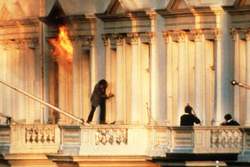 On May 1st, Iran commemorated the fortieth anniversary of the occupation and siege of its embassy in London, United Kingdom by a group of Iranian Arab terrorists.
On May 1st, Iran commemorated the fortieth anniversary of the occupation and siege of its embassy in London, United Kingdom by a group of Iranian Arab terrorists. RNA – Five days after the defeat of the American-led attack on Iran to liberate the hostages taken by the Muslim Students Following the Imam’s Line and Operation Eagle Claw (also known as Operation Tabas), five armed men occupied the Iranian embassy in London and took all twenty Iranian employees of the embassy hostage.
Time of the Attack: 11:30 am on May 1, 1980
Location: 16 Prince’s Gate, South Kensington, London
Number of terrorists: Six people who introduced themselves as the Democratic Revolutionary Front for the Liberation of Arabistan (DRFLA), an Iranian Arab terrorist group founded in 1979.
Number of hostages: 26 employees and clients of the Iranian embassy
Period of hostage-taking: Six days (April 30 to May 5, 1980)
The nature of terrorists: The terrorists were born in Iraq and had Iraqi passports. They applied for visas as Iraqi nationals and entered the United Kingdom without any question about the purpose of their trip, according to court documents.
The terrorists’ demands: The release of 91 Arab prisoners from Iranian prisons, their own safe passage out of the United Kingdom, for them to join the hostages and official recognition of the national rights of the Khuzestani Arab people by the Iranian government.
The Iranian Ministry of Foreign Affairs’ Reaction: In response to the terrorists’ threat to kill the hostages, Iranian Foreign Minister Sadeq Qotbzadeh said, “Let them do that!”
The British Foreign Office’s Reaction: The British Foreign Office had asked ambassadors from various Arab countries to come to London to negotiate with the hostages to help resolve the issue peacefully but none of the Arab diplomats except the representative of the Palestine Liberation Organization (PLO) in London agreed. They didn’t help!
Rescue Operations:
In order to successfully carry out the rescue operation, the Special Air Service (SAS), a special forces regiment of the British Army, while receiving a guarantee of judicial immunity from the consequences of their actions, as well as adequate life insurance coverage, were allowed to shoot without restrictions and kill anyone they saw fit.
The Prime Minister of the United Kingdom, Margaret Thatcher, stressed that all hostages must be kept alive and that all hostage-takers must be killed! The killing of two terrorists who were only guarding the hostages is one of the unsolved puzzles.
After that on the sixth day, the hostage-takers dumped the body of an Iranian diplomat outside the building and the operation began earlier than expected. The whole rescue operation lasted only 15 minutes after SAS forces stormed the embassy.
Reactions and Consequences:
After the incident, Iranian President Abolhasan Banisadr defended the need to release the American hostages immediately, prompting Margaret Thatcher to take advantage of the situation and write letters to Imam Khomeyni and Banisadr to release the American hostages.
In a part of her letter to Imam Khomeyni, Prime Minister Thatcher wrote: “I call on Imam Khomeyni to order the release of American hostages in order to show goodwill to the brave men who risked their lives to free the Iranian hostages and to thank God for protecting the safety of the Iranian hostages.”
John Graham, the British ambassador to Iran, expressed London’s official condolences to the Iranian government over the hostage-taking, the occupation of the embassy and the killing of two diplomats. In response, President Banisadr sent a message of thanks to Prime Minister Thatcher.
Martyrs and Wounded by the Hostage-Takers: Two Iranian diplomats, Dr. Abbas Lavasani (Chief Press Officer) and Ali-Akbar Samadzadeh (a temporary employee at the embassy), were killed, and Gholam-Ali Afrouz-Kardar (Embassy Chargé d’Affaires) and Ali Dadgar, the embassy’s local translator, were wounded by the armed hostage-takers.
The Fate of the Terrorists: Five terrorists were killed. A young man named Fawzi Badawinejad, the only surviving hostage to the accident, was released because he hid among the hostages, who were later identified and arrested outside the embassy compound.
Rasa News Agency
112/972